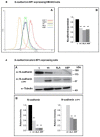RP1 is a phosphorylation target of CK2 and is involved in cell adhesion
- PMID: 23844040
- PMCID: PMC3701075
- DOI: 10.1371/journal.pone.0067595
RP1 is a phosphorylation target of CK2 and is involved in cell adhesion
Abstract
RP1 (synonym: MAPRE2, EB2) is a member of the microtubule binding EB1 protein family, which interacts with APC, a key regulatory molecule in the Wnt signalling pathway. While the other EB1 proteins are well characterized the cellular function and regulation of RP1 remain speculative to date. However, recently RP1 has been implicated in pancreatic cancerogenesis. CK2 is a pleiotropic kinase involved in adhesion, proliferation and anti-apoptosis. Overexpression of protein kinase CK2 is a hallmark of many cancers and supports the malignant phenotype of tumor cells. In this study we investigate the interaction of protein kinase CK2 with RP1 and demonstrate that CK2 phosphorylates RP1 at Ser(236) in vitro. Stable RP1 expression in cell lines leads to a significant cleavage and down-regulation of N-cadherin and impaired adhesion. Cells expressing a Phospho-mimicking point mutant RP1-ASP(236) show a marked decrease of adhesion to endothelial cells under shear stress. Inversely, we found that the cells under shear stress downregulate endogenous RP1, most likely to improve cellular adhesion. Accordingly, when RP1 expression is suppressed by shRNA, cells lacking RP1 display significantly increased cell adherence to surfaces. In summary, RP1 phosphorylation at Ser(236) by CK2 seems to play a significant role in cell adhesion and might initiate new insights in the CK2 and EB1 family protein association.
Conflict of interest statement
Figures




References
-
- Bu W, Su LK (2003) Characterization of functional domains of human EB1 family proteins. J Biol Chem 278: 49721–49731. - PubMed
-
- Su LK, Qi Y (2001) Characterization of human MAPRE genes and their proteins. Genomics 71: 142–149. - PubMed
-
- Su LK, Burrell M, Hill DE, Gyuris J, Brent R, et al. (1995) APC binds to the novel protein EB1. Cancer Res 55: 2972–2977. - PubMed
-
- Renner C, Pfitzenmeier JP, Gerlach K, Held G, Ohnesorge S, et al. (1997) RP1, a new member of the adenomatous polyposis coli-binding EB1-like gene family, is differentially expressed in activated T cells. J Immunol 159: 1276–1283. - PubMed
-
- Bu W, Su LK (2001) Regulation of microtubule assembly by human EB1 family proteins. Oncogene 20: 3185–3192. - PubMed
MeSH terms
Substances
LinkOut - more resources
Full Text Sources
Other Literature Sources
Molecular Biology Databases
Research Materials

